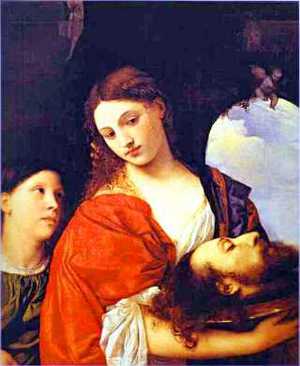Salome. It’s a magical name, and for most people, it conjures an image of a fabled New Testament temptress, whose Dance of the Seven Veils so inflamed her stepfather, King Herod, that he swore to give her any reward she desired, “even up to half his kingdom.” Either prompted by her mother, Queen Herodias, who hated John the Baptist, or driven by her own thwarted desire for the prophet, Salome asked her stepfather for the man’s head on a plate. This well-known version of the tale, however, has more to do with 19th-Century Orientalism than with either the biblical story or with the historical Salome.
Although Salome’s name is well-known, it does not appear in the New Testament. It was recorded by the 1st Century historian Josephus, in his “Jewish Antiquities.” The Bible identifies Salome only as the daughter of Herodias, a Jewish princess, and Herodias’s first husband, her uncle Herod Philip (also known as Herod II or Herod Boethius). After Herod Philip and Herodias divorced, Herodias married Herod Philip’s brother, Herod Antipas. John the Baptist, among others, condemned the couple for incest. The problem was not that Herod Antipas was Herodias’s uncle, but that he was her ex-husband’s brother, and their marriage was forbidden by Jewish law. Although Salome disappears from the Bible after the death of John the Baptist, Josephus records that she went on to marry twice and bear three sons: Herod, Agrippa and Aristobulus.
Herod Antipas imprisoned John the Baptist for his comments about the marriage, but refused to execute him. Knowing how popular John was, Herod may have feared an uprising if he had him killed. But Herodias had no such compunctions. On Herod’s birthday, she made her move.
“And when a convenient day was come, that Herod on his birthday made a supper to his lords, high captains, and chief estates of Galilee. And when the daughter of the said Herodias came in, and danced, and pleased Herod and them that sat with him, the king said unto the damsel, Ask of me whatsoever thou wilt, and I will give it thee. And he sware unto her, Whatsoever thou shalt ask of me, I will give it thee, unto the half of my kingdom. And she went forth, and said unto her mother, What shall I ask? And she said, The head of John the Baptist.
“And she came in straightway with haste unto the king, and asked, saying, I will that thou give me by and by in a charger the head of John the Baptist. And the king was exceeding sorry; yet for his oath’s sake, and for their sakes which sat with him, he would not reject her. And immediately the king sent an executioner, and commanded his head to be brought: and he went and beheaded him in the prison, and brought his head in a charger, and gave it to the damsel: and the damsel gave it to her mother. And when his disciples heard of it, they came and took up his corpse, and laid it in a tomb.” (Mark 6:21-29, KJV)
Typically, this passage is interpreted to mean that Herod Antipas was so aroused by his stepdaughter’s dance that he would have offered her any reward, even half his kingdom, if she would have agree to have sex with him. In the 1923 movie Salome, for instance, starring Alla Nazimova, Herod is depicted as an obese, slavering maniac, who fans himself and yanks at his clothing while his nubile young stepdaughter dances, with the intention of seducing him into murdering John the Baptist, who spurned her sexual advances.
In the koine Greek in which the Gospels were written, however, Salome is described as a “korasion” – a girl too young to marry. Her dance is called “orxeomai,” which suggests the antics of a young child at play. And the word which describes Herod’s reaction to Salome’s dance is “aresko,” which means simply pleased, rather than aroused or titillated. The Greek, then, paints a picture of a young girl dancing playfully for her stepfather, not an accomplished seductress driving a lustful king to the edge of madness. His offer of “half his kingdom” was an extravagant compliment, meant in a spirit of fun. Salome’s vengeful mother, however, seized the opportunity to have the man who had publicly condemned her for incest killed. If this translation is correct, then Salome was either too young to understand what she was asking, or too cowed by her mother to protest. In either case, Salome was as much Herodias’s victim as John the Baptist.
“But,” you may ask, “what about the Dance of the Seven Veils?”
In 1891, Oscar Wilde wrote Salomé, a one-act play in French which premiered in Paris in 1896. (Although it was published in an English translation with illustrations by Aubrey Beardsley in 1894, it was not performed in England until 1931, due to an English law which forbade the depiction of biblical characters on stage.) The Dance of the Seven Veils appears in Wilde’s play, but is not described. Salome merely orders her slaves to bring her perfume and her seven veils, and remove her sandals. The stage directions indicate that “Salomé danse la danse des sept voile” – Salome dances the dance of the seven veils. In Richard Strauss’s opera Salomé, however, which was adapted from Wilde’s play, the Dance of the Seven Veils became a centerpiece of the show. Although the dance itself varies from one production to the next, it is often performed as a strip-tease, in which a scantily clad or nude performer removes the veils one at a time and then lays herself, naked, at Herod’s feet, to demand the head of the man who refused her.
The story of Salome, as most people think they know it, is based on a mistranslation of the biblical text, a play by Oscar Wilde and an opera by Richard Strauss. As the story is told in the Gospels, Salome was an innocent pawn in her mother’s game of revenge.
Reference:
- Biographies of Salome, John the Baptist, Herod and Herodias at Wikipedia: www.wikipedia.org “God Belly Danced, Part III,” by Qan-Tuppim, at The Gilded Serpent: www.gildedserpent.com




